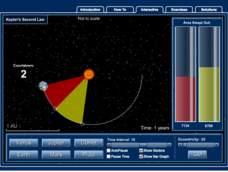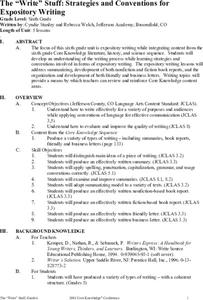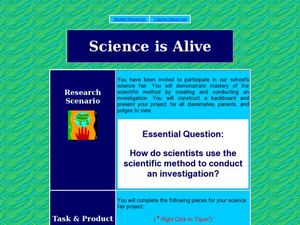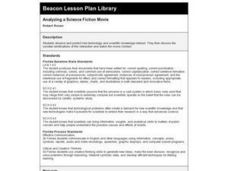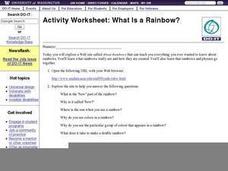Curriculum Corner
Earth Day Book
This Earth Day, celebrate our beautiful planet with an activity book that challenges scholars to show off their map skills, complete a crossword puzzle, write acrostic poems, alphabetize, and reflect on their personal Earth-friendly habits.
Pace University
Volume and Capacity
Differentiated instruction through leveled learning contracts boosts scholars' knowledge of volume and capacity. Participants split into three groups based on ability and interest before choosing three activities from their learning...
California Academy of Science
Natural Resources Bingo
Bingo isn't just a silly game, it's a great way to practice all types of skills. After reviewing that the earth is composed of natural resources, what those natural resources are, and sustainability, the class plays a game of bingo. The...
NOAA
Prepare for the Storm!
Severe weather can occur with or without warning. Being prepared for any situation makes chances of survival that much greater. A brief activity suggests a list of items for an emergency book bag. The first page provides 12 suggested...
New South Wales Department of Education
Photosynthesis
Venus fly traps photosynthesize and consume insects because the soil they live in does not provide enough nutrients. Scholars analyze historical scientific experiments to learn how scientists discovered photosynthesis. From their...
McGraw Hill
Kepler's Second Law Interactive
Kepler decided to think outside the box and discovered that planets orbit in elliptical patterns. An engaging activity demonstrates the elliptical orbit pattern in relationship to the area of a planet to explain Kepler's Second Law....
NOAA
Subduction Zones
Sink into an interactive learning experience about subduction zones! Junior oceanographers examine the earth-shaking and earth-making effects of subduction in the fourth installment in a 13-part series. Hands-on activities include...
Science Matters
Formative Assessment #4: Body Chart
The body is one big life-sized puzzle! A hands-on lesson builds on the idea and has individuals create life-size models of the body including all important organs of the digestive, circulatory, and respiratory systems. After building...
Exploratorium
Breakfast Proteins - Construct a Protein through Cereal Additions
Match my cereal sequence. Pupils view a sequence made by colorful cereal rings and create copies of it. Learners must either remember or write down the sequence to transport the code to another location. Scholars replicate the cereal...
Curated OER
Science Puzzlers, Twisters & Teasers: The World of Physical Science
Challenge your class with these physical science puzzlers, twisters, and teasers. Each individual responds to a series of riddle-style questions that are related to scientific terminology. While this has little educational value, it...
Curated OER
WET Science Lesson #3: Comparison of Aquatic and Terrestrial Plants
Elementary life science explorers compare and contrast aquatic and terrestrial plants (elodea and soybeans) in a Venn diagram. Some background information is provided to support direct instruction, and general instructions are provided...
Alabama Learning Exchange
Safety in the Science lab
High schoolers work in groups to write and produce a video on laboratory safety. They use video equipment correctly and effectively work in groups. They develop basic acting skills with the help of peers and drama teacher.
Curated OER
Aerobic vs. Anaerobic Respiration
Students define aerobic and anaerobic respiration. They compare and contrast the processes of aerobic and anaerobic respiration. Students identify organisms that use the processes of aerobic and anaerobic to synthesize energy from food.
Curated OER
Identifying Science Fiction
High schoolers discuss works of science fiction that they read, highlight aspects that made each a part of science fiction genre, identify formal literary elements, and discuss ways each can be developed through science fiction.
Curated OER
The "Write" Stuff: Strategies and Conventions for Expository Writing
Students develop their expository writing skills while integrating various other subjects. In this writing skills lesson, students complete 4 multiple activity lessons to improve their expository writing skills.
Curated OER
Science is Alive
Students explore the scientific method. In this science lesson, students create and conduct a science investigation for the science fair.
Curated OER
Analyzing a Science Fiction Movie
Fourth graders watch the movie "Contact" and write a review. They discuss in their review how scientists deal with technological problems, the movie's connections to the nature of science and how technology affects science. They share...
Curated OER
What Is a Rainbow? Internet Research and Writing Activity
In this rainbow worksheet, students research information about rainbows using an assigned web site. They explore the site to find the answers to the 6 questions included on the worksheet.
Curated OER
Cloze Activity: The Water Cycle
In this recognizing the water cycle cloze activity instructional activity, students use the words in the word box to fill in the blanks about evaporation, condensation, precipitation, and runoff. Students write 23 answers.
Curated OER
Science: Bees: An Interdisciplinary Approach
Young scholars investigate the world of bees and describe their characteristics. by identifying the bees' parts, they demonstrate how these parts function. In the lab, students dissect bees and view the various parts under microscopes....
Curated OER
Writing the Wind
Students make a windmill. In this wind lesson, students learn background information about the windmill, complete an activity where they create a windmill, discuss using wind as a natural resource and brainstorm other inventions that...
Curated OER
Getting In Is Half the Battle
Students read and discuss "Defending Affirmative Action With Social Science," examining the admissions policies in public universities and colleges. They write persuasive essays either for or against the admissions policies in their state.
Curated OER
Hands-On Outlining
In order to write an effective outline, children must be able to identify main ideas and supporting details, which is the aim of this fun and kinesthetic activity. The class works on the floor to organize sentence strips prepared by the...
Curated OER
Using Citations in a Research Paper
As a prequel to a research assignment, class members explore writing citations in the modern Language Association (MLA) and American Psychological Association (APA) formats. In pairs, or individually, researchers use books and magazines...







